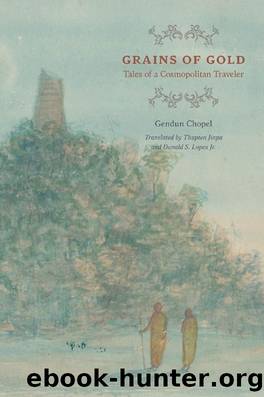Grains of Gold: Tales of a Cosmopolitan Traveler (Buddhism and Modernity) by Chopel Gendun

Author:Chopel, Gendun [Chopel, Gendun]
Language: eng
Format: epub
Publisher: University of Chicago Press
Published: 2014-01-17T00:00:00+00:00
12
The PÄla Dynasty
At the same time as this [Lohara] dynasty and when it had been more than one thousand two hundred years since the Buddhaâs passing, the PÄla kings ruled in Bengal. This dynasty lasted for a very long time. They made their chief capital at Sahora or Zahor. Regarding what are said to be the ruins of that city, there is one on the banks of the BrahmÄputra in Bengal and another on the southern bank of the Ganges near Bihar. At both of these there are ruins of palaces, and so on. The first [king] of the PÄla dynasty was GopÄla. After the death of the king of Gauá¸a, the Bengalis came under the sway of Matsya and were miserable. The people of the country gathered and appointed GopÄla as their king. He restored the damaged kingdom and ruled the land well. Regarding the statement that GopÄla built VikramaÅÄ«la [monastery], I have not heard anything other than what is familiar to us; and I do not see any difficulty [with this statement], such as an inconsistency in the chronology. However, because about three GopÄlas appeared during this dynasty, one should investigate to determine which one it was [who built the monastery]. His son was the great king DharmapÄla and he ruled from the city of PÄá¹aliputra. He defeated such [rulers] as IndrÄyudha, king of Kanauj, and brought it under his dominion, and appointed a new king in his place. He remained the archenemy of RÄá¹£á¹rakÅ«á¹a, NÄgabhaá¹a, and the like. He was known to have controlled the entire land from the edge of the snow mountains to Gokará¹a [in Karnataka] in the south.
He held the three jewels to be supreme and protected both non-Buddhists and Buddhists without being partisan. During the period of DharmapÄla, due to such things as our country flourishing, even we [Tibetans] became quite familiar [with this king]. In fact, when the name of [any other] Indian king appeared, he was referred to as DharmapÄla, and some even wrote that the son of such and such [a king] came to Tibet, and so on. Regarding his descendants, even the fifth Dalai Lama considered himself to belong to this lineage.1 However, I do not know if the family line of ÅÄntaraká¹£ita and AtiÅa are the same as this [Sahor lineage] or not.
Within the PÄla dynasty, this king [DharmapÄla] is as famous as the sun and moon, and among the Buddhist kings of the later period, none is greater than he. The kings of the lands of Matsya, Kuru, Yadu, Avanti, GandhÄra, and so forth were known to accept his authority. In the one thousand three hundred twenty-sixth year after the passing [of the Buddha or 782 CE; he reigned from 770 to 810 CE] he was alive and ruling his kingdom. This can be correlated with the statement in the Red Annals that Ogyenpa (1229â1309) saw on the stone pillar at the Yarlung tombs, [which states] that, at the time of Tibetan emperor Sena Lekzin, DharmapÄla was in India.
Download
This site does not store any files on its server. We only index and link to content provided by other sites. Please contact the content providers to delete copyright contents if any and email us, we'll remove relevant links or contents immediately.
Annapurna by Maurice Herzog(3403)
Liar's Poker by Michael Lewis(3330)
A Forest Journey by John Perlin(3012)
Atlas Obscura by Joshua Foer(2768)
The Ogre by Doug Scott(2606)
Cuba by Lonely Planet(2533)
Photographic Guide to the Birds of Indonesia by Strange Morten;(2469)
Tokyo by Rob Goss(2348)
All Things Reconsidered by Bill Thompson III(2333)
The Splendid and the Vile by Erik Larson(2307)
A TIME OF GIFTS by Patrick Leigh Fermor(2136)
INTO THE WILD by Jon Krakauer(2135)
Fatal Storm by Rob Mundle(2112)
Trail Magic by Trevelyan Quest Edwards & Hazel Edwards(2109)
DK Eyewitness Top 10 Travel Guides Orlando by DK(2082)
Top 10 Dubai and Abu Dhabi by DK Travel(2035)
Abbey in America by Murray John A(2032)
Touching the Void by Joe Simpson(2024)
Lonely Planet Australia by Lonely Planet(2010)
